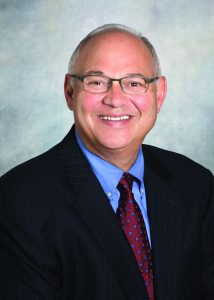Wells Fargo economist says Trump will likely help economy

Mark Vitner
President-elect Donald Trump will likely have a positive impact on the regional and national economy in the short term in the form of tax cuts and ramping up defense spending, Wells Fargo Senior Economist Mark Vitner said.
Trump claims he will reduce personal and corporate income taxes, which would theoretically spur investment in the U.S. Trump also aims to eliminate sequestration cuts on defense spending that have hurt contractors that serve the Vandenberg Air Force Base near Lompoc and the Naval Base in Port Hueneme.
This could take effect in the first half of 2017 and give a “much-needed” boost to the economy, Vitner said.
But the long-term implications get a little fuzzier, he said.
“The economic plan looks fairly good for the economy in 2017,” Vitner said at Wells Fargo’s U.S. and California Economic Outlook at the Canary Hotel in Santa Barbara on Nov. 18. “The real question mark is over the long run because we are going to have larger budget deficits.”
Annual U.S. Defense Department spending on government contracts in the Tri-Counties has been slashed in half since 2012, according to a Business Times analysis.
Spending on Ventura County defense contracts peaked in 2009 when they totaled $1.3 billion, falling to $815 million in 2012 and $436 million in 2016. A similar scenario played out in Santa Barbara and San Luis Obispo counties.
“I think there is widespread agreement that cuts have been very painful. They really hit the local contractors that serve the military bases,” Vitner said.
Some of the infrastructure improvements Trump has vowed to fund would take much longer, especially in California with its rigorous environmental review process, he said. Inflation may go up along with increased infrastructure spending, but it will occur so far down the line that it’s not likely to “strain resources all that much,” Vitner said.
The potential tax cuts coupled with a jump in infrastructure spending could add as much as 1.5 percent to 2 percent growth, amounting to a significant fiscal stimulus, according to a Nov. 16 Capital Group webinar titled “The Votes Are in. Now What?” Equity earnings are likely to grow between 5 percent and 7 percent between now and the end of 2017, even without tax cuts or stimulus measures, the webinar concluded.
Another question mark revolves around trade implications. Renegotiating trade agreements could be a good thing, but if it results in tariffs, it would be a “Pandora’s box,” Vitner said.
“You don’t know how people would respond,” he said. “When you think about the industries in the U.S. that export, those are our most competitive industries where we are creating higher-paying jobs. The retaliatory tariffs that we could likely see would hit our most competitive industries.”
Ultimately, Trump’s projected 4 percent GDP growth is probably a little lofty, Vitner said.
Interest rates are expected to increase at the December Federal Open Market Committee meeting, as monetary policy seems to be moving away from combating deflation and more toward preventing asset bubbles, he said.
Vitner doesn’t expect a recession in 2017 but he would be “mildly surprised” if there wasn’t one in 2018. But it won’t be as devastating as the Great Recession, he said.
While the potential moves in long-term interest rates are probably overstated, Vitner said, it would slow the already gradual housing market recovery.
Single-family construction is gaining momentum but affordability hurdles have put a relatively low ceiling on growth. Home price appreciation has moderated but prices are still rising faster than incomes. The share of households that can afford a median-priced home continues to fall in most of California, the forecast found.
A recent report from MagnifyMoney found that Santa Barbara and San Luis Obispo counties had some of the least affordable housing markets in the entire country. For residents ages 25 to 44, Santa Barbara was ranked the second most difficult place to afford a home out of 380 surveyed regions while SLO was ranked sixth.
Employment growth is trending at a 2 percent annual pace as hiring in the relatively low-wage Santa Barbara County leisure and hospitality sector has continued to increase while professional and business services employment has stumbled.
Residential construction activity remains muted in Santa Barbara and Ventura counties. The number of single and multifamily permits are near recession-lows.
“It’s tough to build in California,” Vitner said. “(Construction) numbers are still well off their historic norms in California.”
• Contact Alex Kacik at [email protected].












